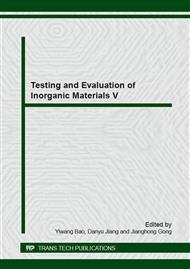[1]
C. Moura Branco, J.M. Ferreira, P. Faelt, A comparative study of the fatigue behaviour of GRP hand lay-up and pultruded phenolic composites, Int. J. Fatigue 18 (1995) 255–263.
DOI: 10.1016/0142-1123(95)00059-3
Google Scholar
[2]
M.C. Wang, L.H. Wei, T. Zhao, A novel condensation-addition-type phenolic resin (MPN): Synthesis, characterization and evaluation as matrix of composites, Polymer 46 (2005) 9202–9210.
DOI: 10.1016/j.polymer.2005.06.009
Google Scholar
[3]
C.K. Lee, Corrosion and wear-corrosion resistance properties of electroless Ni–P coatings on GFRP composite in wind turbine blades, Surf. Coat. Technol. 202 (2008) 4868–4874.
DOI: 10.1016/j.surfcoat.2008.04.079
Google Scholar
[4]
J.W. Yoon, J.H. Park, C.C. Shur, Characteristic evaluation of electroless nickel-phosphorus deposits with different phosphorus contents, Microelectron. Eng. 84 (2007) 2552–2557.
DOI: 10.1016/j.mee.2007.05.057
Google Scholar
[5]
K.N. Srinivasan, S. John, Electroless nickel deposition from methane sulfonate bath, J. Alloys Compd. 486 (2009) 447–450.
DOI: 10.1016/j.jallcom.2009.06.178
Google Scholar
[6]
C.W.M. Yuen, S.Q. Jiang, C.W. Kan, W.S. Tung, Influence of surface treatment on the electroless nickel plating of textile fabric, Appl. Surf. Sci. 253 (2007) 5250–5257.
DOI: 10.1016/j.apsusc.2006.11.044
Google Scholar
[7]
S.Y. Cheon, S.Y. Park, Y.M. Rhym, D.H. Kim, J.H. Lee, The effect of bath conditions on the electroless nickel plating on the porous carbon substrate, Curr. Appl. Phys. 11 (2011) 790–793.
DOI: 10.1016/j.cap.2010.11.076
Google Scholar
[8]
I. Páczelta, S. Kucharski, Z. Mrózb, The experimental and numerical analysis of quasi-steady wear processes for a sliding spherical indenter, Wear 274–275 (2012) 127–148.
DOI: 10.1016/j.wear.2011.08.026
Google Scholar
[9]
D.B. Lewis, G.W. Marshall, Investigation into the structure of electrodeposited nickel–phosphorus alloy deposits, Surf. Coat. Technol. 78 (1996) 150–156.
DOI: 10.1016/0257-8972(94)02402-2
Google Scholar
[10]
S.Y. Cheon, S.Y. Park, Y.M. Rhym, D.H. Kim, J.H. Lee, The effect of bath conditions on the electroless nickel plating on the porous carbon substrate, Curr. Appl. Phys. 11 (2011) 790–793.
DOI: 10.1016/j.cap.2010.11.076
Google Scholar
[11]
J.Y. Song, J. Yu. Residual stress measurements in electroless plated NiP films, Thin Solid Films 415 (2002) 167–172.
DOI: 10.1016/s0040-6090(02)00556-4
Google Scholar
[12]
M. Yan, H.G. Ying, T.Y. Ma, Improved microhardness and wear resistance of the as-deposited electroless Ni–P coating, Surf. Coat. Technol. 202 (2008) 5909–5913.
DOI: 10.1016/j.surfcoat.2008.06.180
Google Scholar
[13]
A. -F. Kanta, V. Vitry, F. Delaunois, Wear and corrosion resistance behaviours of autocatalytic electroless plating, J. Alloys Compd. 486 (2009) L21–L23.
DOI: 10.1016/j.jallcom.2009.07.038
Google Scholar
[14]
K.H. Hou, M.C. Jeng, M.D. Ger, A study on the wear resistance characteristics of pulse electroforming Ni–P alloy coatings as plated, Wear 262 (2007) 833–844.
DOI: 10.1016/j.wear.2006.08.023
Google Scholar
[15]
K.G. Keong, W. Sha, Crystallisation and phase transformation behavior of electroless nickel–phosphorus deposits and their engineering properties, Surf. Eng. 18 (2002) 329–343.
DOI: 10.1179/026708402225010010
Google Scholar
[16]
R. Rajendran, W. Sha, R. Elansezhian, Abrasive wear resistance of electroless Ni–P coated aluminium after post treatment, Surf. Coat. Technol. 205 (2010) 766–772.
DOI: 10.1016/j.surfcoat.2010.07.124
Google Scholar


